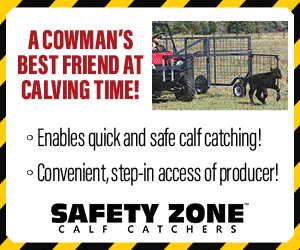I’m Not Spreading BDV
– By MERRIDEE WELLS –
Calving season on the ranch is always an exciting time. The work of the past year, the offspring of that newly purchased bull, or the mating decisions you’ve made are about to be rewarded. So imagine, if you will, how it feels to find first one dead fetus, then another. Or to realize that one or more of those new bred heifers you purchased won’t be calving this year, ‘cause she’s open. Or maybe it’s worse. Maybe one or more of your cows will be giving birth to a true “fetal monster” of the worst kind… a BVDV-PI carrier. So what happened?
Perhaps the answer lies in understanding the disease; Bovine Viral Diarrhea Virus (BVDV) and its truly heinous cousin, the persistently infected version or PI. When a BVDV outbreak occurs in the cowherd the most common problems associated with the BVD virus infection are poor conceptionrates, abortions, stillbirths, and weak calves, and because this virus suppresses the immune system, animals become more readily susceptible to other infectious diseases. Thus cattlemen notice increased calfdeath due to scours and pneumonia and poor weaning weights. This is not a disease that should be taken lightly since it could have such a negative economic impact on your program.
The PI or persistently infected animal is a lifelong carrier and shedder of the BVD virus, and that’s pretty serious, too. This is an animal that was infected at 40-150 days of gestation (in uterine). The developing fetus recognizes the virus as part of itself, a condition called immunotolerance. Because the virus is recognized as part of the fetus, it is not attacked. Instead, the virus continues to replicate as long as the fetus is alive, or more importantly as long as the animal is alive once it’s born. And, interestingly enough, the dam of the PI calf is not always a carrier.
BAD NEWS AND REALLY BAD NEWS
The PI animal is the silent infector that, if left in the herd, continually infects and reinfects animals. It’s the one out of every 1,000 that typically is a PI among the general cowherd population. However, on individual operations prevalence can be much higher because of “bunching”. In this scenario, BVDV is actively circulating among a group of pregnant females that are at the correct stage of gestation for PIs to be created. The PI animal sheds huge amounts of BVD virus throughout their lifetime. The virus can be shed through feces, semen, nasal discharge, coughing, oral diffusion, blood transference on needles, colostrums, milk and placenta to the calf, with the most likely source being respiratory transmission. The bad news is that about 50% of BVDPI calves are poor-doers who generally die before they reach their first birthday. The really bad news: the other 50% appear as healthy calves that grow normally and enter the breeding herd or the feedlot. These are the really dangerous ones.
Dr. Brad White, with Kansas State University (KSU) Beef Production Medicine has extensive experience with the disease. In fact, through work with the Academy of Veterinary Consultants and the National Cattlemen’s Beef Association special focus committees, a team has developed a website, www.bvdinfo.org, which features a tool called BVD CONSULT. This tool allows ranchers and veterinarians to enter specific characteristics of their herds and generate a customized health management recommendation for that herd.
“Nationwide about 7% of cow herds are infected with BVDV,” says White. There are two broad genotype categories for BVD strains in the U.S.; Type 1 and Type 2. “Understanding whether or not your herd is one of those infected will impact the importance of instituting different control and preventative measures.”
“By using the BVD CONSULT tool on the bvdinfo website, producers can enter specific characteristics of their herd and generate a customized health management recommendation for their cowherd,” White continues. In other words, is your situation bad enough to warrant a complete herd test or not? Dr. White leans toward evaluation of production parameters such as pregnancy rates, calf deaths and illness to drive the need for testing.
“Several syndromes could cause reproductive losses in a cow/calf operation but BVD should be on the list of potential causes,” he explains. Washington State University’s Animal Disease Diagnostic Lab (WADDL) also has an excellent website which advises producers on when, where and how to test, with samples (ear notches) being sent to their facility
for diagnosis. The WADDL website recommends that herds should be examined on a case-by-case basis to determine the need for testing, because whole herd testing may not be warranted.
However, WADDL suggests testing of the following to identify and remove BVD-PI cattle if a problem is suspected.
CALVES
1. Test all calves born alive. Most conveniently this should be done at calving or before turnout to summer or winter range, but most definitely before any potential replacements enter the breeding herd.
2. All aborted calves (that can be found).
3. All purchased grafted calves.
COWS
1. Test all cows with a BVD-PI positive calf.
2. All open cows not sold.
3. Cows not calved at time of sampling.
4. All cows that lose a calf, and the calf wasn’t sampled.
NEW ENTRIES
1. Purchased open heifers.
2. Purchased pregnant heifers and
cows (also test calf when born).
3. Bulls.
Carl Lufkin, managing partner of KCK Leodore Angus Ranch, Leodore, Idaho, is concerned about the disease and feels it is his and other seedstock producer’s responsibility to provide customers with BVD-PI free bulls.
“A few years back we tested our entire cowherd for BVD. We didn’t have any positives,” Lufkin said. “We then started routinely testing our bulls for BVD-PI, just as we would Trich. About 60 days before our bull sale, when the vet is there doing the fertility test, they take an ear notch sample from each bull and test that. Again, we’ve never had a positive test returned on our bulls.”
The Leodore operation primarily runs cattle on public lands, therefore management is very conscious of keeping problems like BVD-PI, Trich and other reproductive diseases away from their cowherd. “We vaccinate pre-breeding with a modified live vaccine, which has been instrumental in keeping BVD out of our herd,” Lufkin concludes.
FIND THE CULPRIT
More and more, BVD-PI testing of bulls has become customary, like Trich or fertility testing; especially those being sold at public auction. In some cases, testing is mandatory, similar to the requirements for producers bringing bulls to sell, show or display at the National Western Stock Show in Denver. The National Western is very specific in their wording which states that no bulls will be allowed on the grounds without a negative test for BVD-PI.
So what to do if you have a PI?
Because BVDV is not a zoonotic pathogen and is no threat to human food, PI cattle can be immediately slaughtered (all slaughter cattle must be free of drug residue, of course – see withdrawal times on the package insert). If they have been treated for some reason, they must be set aside until the product withdrawal time expires before being sent to slaughter. The third option is humane euthanasia and proper disposal of the carcass. Everyone is in agreement that PI cattle should never be sold on the open market.
Annual vaccinations for the disease will usually suffice to keep the problem in check, but they will not “cure” a herd that has PIs present who continue to expose herdmates to the virus. Prevention is the best line of defense; however, if you suspect a problem, testing is an alternative that will determine the culprit. Talk to your veterinarian or go online to www.bvdinfo.org for more information.





